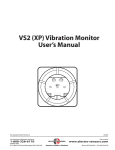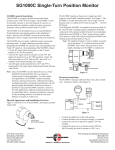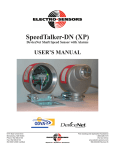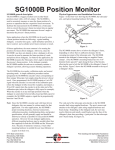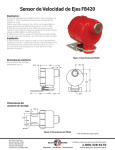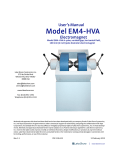Download ASiSA USER`S MANUAL - Electro
Transcript
ASiSA AS-Interface Speed Alarm USER’S MANUAL ���������� ����� ����� � � ����� � � ��� 6111 Blue Circle Drive Minnetonka, MN 55343 Phone: 952.930.0100 Fax: 952.930.0130 ISO 9001:2000 Certified ����� Free Catalog and Application Assistance 1.800.328.6170 Visit Us Online www.electro-sensors.com 990-002800 Revision C Description ASiSA continuously monitors rotating shaft speed, comparing it to a trip-point setting and alarming when less than the trip-point. The ALARM state is accessible over AS-Interface communications and visibly indicated by the internal ALARM led. The rugged unit requires a shaft-mounted magnetic pulser target (disc or wrap) such as the model 255 pulser disc (included). The rotating pulser target produces an alternating magnetic signal at ASiSA’s stationary sensing head. The signal frequency varies in direct linear proportion to the rotating target’s rpm. ASiSA senses this frequency and compares it to the TRIP-POINT setting. When the frequency falls below the TRIP-POINT setting, ASiSA is alarmed. When the frequency exceeds the TRIP-POINT setting, ASiSA is not-alarmed. Measurable Speed Range The ASiSA TRIP-POINT frequency is adjustable within the range: 0.53 → 27 Hz. The frequency (f) to RPM conversion is given by the formula: RPM = f * 60 / PPR Where f is in Hz (pulses per second) and PPR is pulser target pulses-per-revolution. Since RPM changes inversely with PPR, increasing PPR scales TRIP-POINT RPM range down: Pulser Target Corresponding TRIP-POINT RPM range Model 256 Pulser Disc (4 PPR) 8.0 → 400 Model 255 Pulser Disc (8 PPR) 4.0 → 200 Custom Pulser Wrap (16 PPR) 2.0 → 100 AS-Interface Profile S-B.A.E (A/B slave free profile, I/O code B) AS-Interface Parameter bits P3 (master Write Parameter info) AS-Interface I/O Data bits P2 P1 P0 unused unused unused D2 D1 D0 unused unused D3 Output (master Data Exchange req. info) ALARM unused (1) Input (slave Data Exchange resp. info) ALARM (D3) polarity 1 (Alarmed) - speed less than TRIP POINT setting 0 (Not Alarmed) - speed greater than TRIP POINT setting LEDs LED ON OFF ALARM Alarmed Not Alarmed POWER Receiving Power Not Receiving Power ASi (status) Communication OFF Communication ON 2 Mechanical installation ASiSA may be mounted on rigid conduit or with the mounting bracket assembly (provided). The gap (A) between the sensing head and the Pulser Disc/Wrap must be 1/16 to 1/4 inch. The center line of the magnets (B) must align with the center of the sensing head as the Pulser Disc/Wrap rotates. Remove the round cover from the housing and pull AS-Interface network cable through the conduit port into the enclosure. Connect the 2 cable wires to the terminal plug. B A With Pulser Disc Target � A A With Pulser Wrap Target 3 Setting the TRIP-POINT With network power applied and the shaft turning at normal operating speed, slowly turn the TRIP-POINT potentiometer clockwise until the ALARM led turns on. Then slowly turn the TRIP-POINT potentiometer counter-clockwise until the ALARM led turns off. How far below this point you set the TRIP-POINT will determine how far below the current shaft speed the ASiSA will alarm. Firmly screw the round cover back onto the housing for normal use. Specifications Connector 2-conductor “phoenix-style” terminal plug Power (network supplied) 20 → 31.6 Vdc, 30 mA maximum TRIP-POINT Potentiometer (single-turn, 280°, linear response) 0.53 → 27 Hz (4.0 → 200 rpm with 8 PPR disc/wrap) Setting Range LED indicators AS-Interface ALARM (red), POWER (green), ASi status (red) Specification Extended (A/B) addressing Profile V2.11 Yes S-B.A.E Airgap (sensing head to Disc/Wrap) 1/16 → 1/4 inch (2 → 6 mm) Operating temperature -25 → +85 °C (-13 → +185 °F) Enclosure hazardous locations ratings Weight Class I, Div 1, Group C, D Class II Groups E, F, G UL File: E249019 (with bracket) 2.45 Lb (1.11 kg) Dimensions (with bracket) (in inches) 1.84 4.40 0.25 1.38 4.81 3.90 4.00 2.38 1" NPT 1.250 0.260 2.750 1.630 0.560 0.316 4






